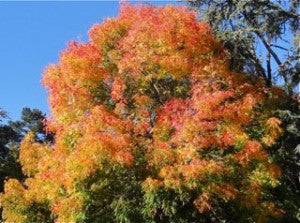ACCORDING TO JOHN: Cultivars, the Perfect Tree and Allergies
Cultivars Creating plant cultivars or new varieties is a big business in horticulture. Some of you may be confused by the names that abound and appear anew attached to familiar plants. Even something as mundane as dwarf boxwood, which many are familiar with as a low, usually formal or at least structured hedge that is subject to turning brownish or reddish in the winter because of low temperatures. Plant breeders and hybridizers look at this as a challenge to create a new special variety or cultivar of boxwood that won’t look brown in the winter and so ‘Green Beauty’ and ‘Winter Gem’ Boxwood were created and marketed.
This practice goes on in almost every genus of plant that are available at nurseries and that’s what you are looking at when you see an additional name attached to the end of the botanical name or even to the common name. These are cultivars which usually are more expensive and are better for one reason or another or were, at least, developed to be better. A tree like the prehistoric Maidenhair or Ginkgo tree is Ginkgo biloba and was around during the time of the dinosaurs. It has beautiful fall color and the female produces a smelly, messy fruit. So cultivars were created, Ginkgo biloba ‘Autumn Gold’, ‘Fairmount’ or ‘Saratoga’ that are grafted, instead of being grown from seed and the graft guarantees the tree will be male and will have a certain desirable form and fall color.
The Perfect Tree So, since we have this power, let’s make a perfect tree. Something like the beautiful Chinese Pistache is already almost perfect because it grows at a good rate to create abundant shade, is usually not subject to pest or disease, has fairly well behaved roots for a large tree and has beautiful fall color. But being the complainers we are, some of us don’t like the innocent and well-intentioned Pistache because the female trees produce abundant seeds that drop and can be messy and because some of the Pistache aren’t as colorful as that gorgeous one the neighbor has. Let’s plant a zillion Pistache seeds, pick out one that is male so that it won’t produce seeds and one that has the most beautiful color known to mankind, and then use wood from that tree to graft seedling Pistache to grow the perfect tree. A man named Keith Davey did just that and the result is a really desirable, well behaved, beautiful shade tree called Pistacia chinensis ‘Keith Davey’. Is it perfect? In many ways, yes it is…almost.
Allergies Then Thomas Ogren, a University horticulture professor, ruined our hopes and dreams. He said planting a ‘Keith Davey’ is the worst thing you could do because male trees produce loads of pollen and they spread all over our environment, while female trees trap pollen. He wrote a book with the most exciting name in the history of gardening, “Safe Sex in the Garden”. Tom, Tom, Tom! It’s not what you think; it’s more about pollen and nasal passages than bringing a whole new excitement to gardening. Professor Ogren implores, “People with allergies or asthma deserve clean air to breath. Kids deserve schools that are not covered in pollen. I need your help to get the word out. I need help to get city arborists to stop planting all these male trees. I need help to get people to appreciate a fruiting female tree because she never sheds any pollen. I need your help to educate the allergists. I need your help to get cities to enact and enforce pollen control ordinances. I need your help to get the colleges and universities to start teaching this material in their landscape design classes, their urban forestry studies, in all of the horticulture classes.” Even the almost perfect ‘Keith Davey’ isn’t perfect and has its detractors. There are lots of interesting and important issues like this in horticulture. Some of you may need an educated source, with substantial experience, without an agenda and with a genuine commitment to the life improving capabilities of horticulture/gardening/landscaping. If so, whether you are a homeowner or professional, keep reading this blog and feel free to send me questions. I’ll answer promptly and thoroughly, without judgment, whether it is a great, mundane, or inane question.


